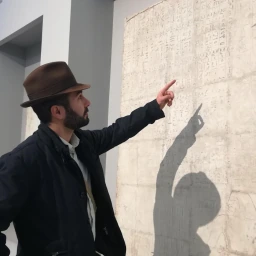A soft fog was reflecting the lights back towards the deserted road, like dancing figures and projections of shadows. Suddenly, a small flocks of migrating birds passed over the car, disturbing the quiet air of the plain. Here, along the Po valley, is cold and the humidity raises quickly.
After a wide curve in the road, the city of Pieve Terzagni appeared through the fog. It is a small village of four hundred inhabitants located in the Italian province of Cremona. Nonetheless, Pieve Terzagni is not just a small city lost in the plain but it hosts an ancient treasure, which has come down to our days between the past and the modernity.
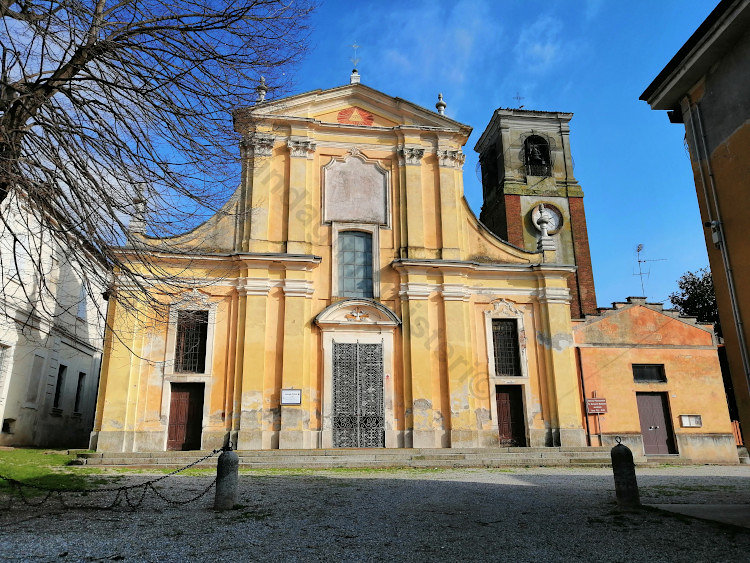
San Giovanni Decollato in Pieve Terzagni
The church of San Giovanni Decollato overlooks the central square called “Martiri della Libertà“. It could seem to be of Baroque style and the exterior of the building reflects a 17th and 18th century architecture. Nevertheless, the church keeps inside some precious Romanesque remainings, and over the apse an impressive mosaic floor is well preserved. Allegedly, San Giovanni Decollato was founded in the 12th century by the will of Matilda of Tuscany. The current building has maintained the original structure with one nave and two aisles with a basilica plan. Of the original church only one column, the cross vaults and some amazing decorations have survived.
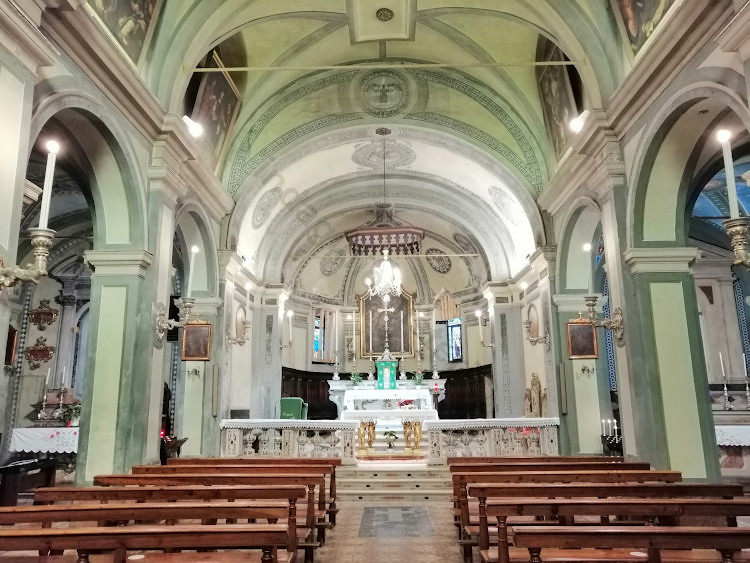
The mosaic floor
The artistic excellence of its master builders can be appreciated thanks to the beautiful mosaic floor tiles over the presbytery area. They are composed by hundreds white and black tesserae dating back to around 11501; only a few number of them have light colored pigments. The subjects of the mosaics include sacred or symbolic scenes, often inscribed in round shape with decorative frames.
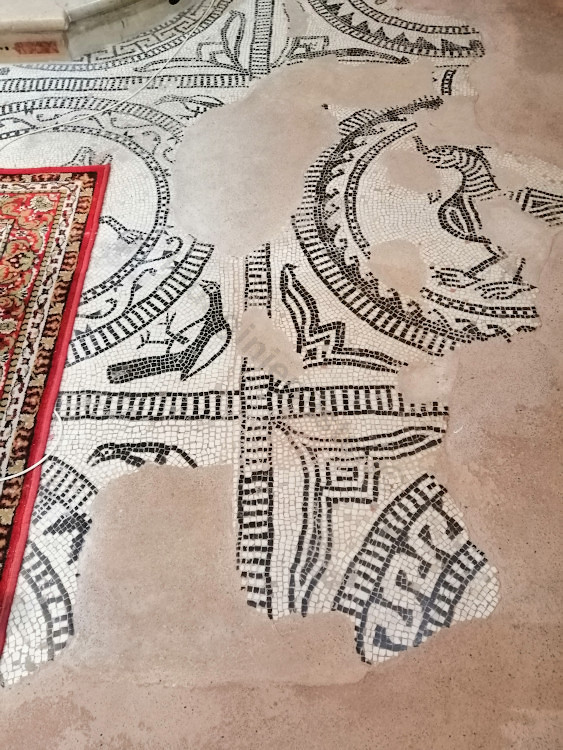
Unfortunately, the artwork has been partially modified due to a destructive 17th restoration, consequently it has lost its original harmony getting into a composition of difficult interpretation. The tiles of the mosaic have been lost both in a metaphorical dimension and in the figurative one.
A graphic rendering of the mosaic floor was proposed by Aus’m Weerth, who visited the church in 1873, revealing the most preserved part is over the presbitery area2.

The presbytery area of San Giovanni in Pieve Terzagni
The chancel of the church hosts the symbolic representation of the four evangelists (Tetramorph) on the corners and also figures of mythological and real animals. Among them, there is a griffin, a mythical animal with an eagle’s head and the body of a lion. It is a symbol of Christ on account of its double nature, heavenly and terrestrial. The representations are mainly connected to the exegetical significance of the God’s Word in the sacred Bible.


According to this evidence, the figure of the proto-martyr Stephan, under an arch with columns and Greek crosses, occupies the central part of the mosaic. The Greek words on the sides (Stephanus diakwuws) reveal the subject is the first deacon of the Catholic Church. Stephan holds the Gospel book and his representation indicate the position of the reader in the presbytery. Thus, it is possible that exactly here was a mobile altar for the office of readings.
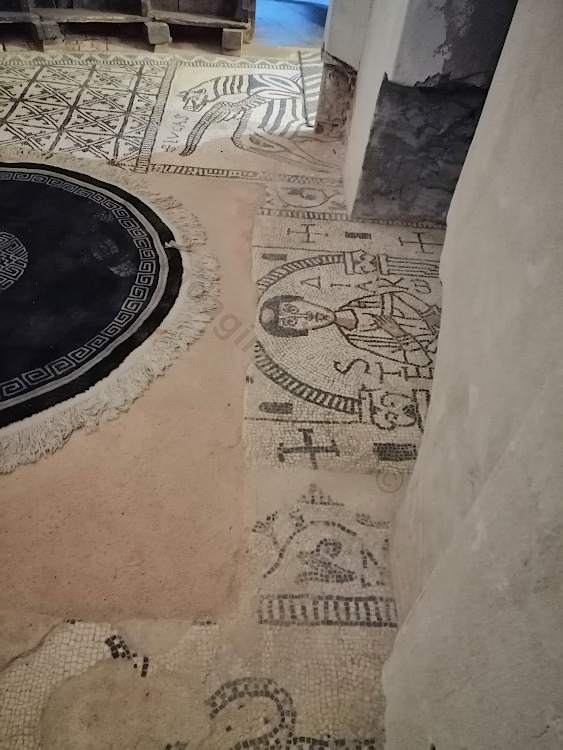

The picture of the vices and the sins
At the beginning of the central nave the floor mosaic depicts wild animals and fears symbolizing the vices and sins of the human being. They are inscribed inside round shape by a grid of twelve squares. Here the visitor can observe a temptress two-tailed siren, symbol of lust; possibly a donkey, that was expression of the sloth in the Middle Ages; some birds, like a turkey and a chicken; some felines, symbol of pride; a wolf, traditionally associated to greed and heresy.

The jusxtaposition of mythological and real animals should not surprise anyone. Medieval people had a different conception of reality compared to today. The modern one, in fact, is linked to an objective and demonstrable reality, legacy of both the Positivism and the Enlightenment. Medieval people gave importance even to the possibility of existence of something by faith. Nobody had never seen a griffin before but what mattered was the symbolism attributed to this imaginative animal. Hence, the representation of the fears was not similar to the reality at all, rather it was a grotesque personification of a characteristic depending on the symbolic message. On one hand this gives Medieval art a fascinating mystery, on the other hand it gets complicated its figurative interpretation.

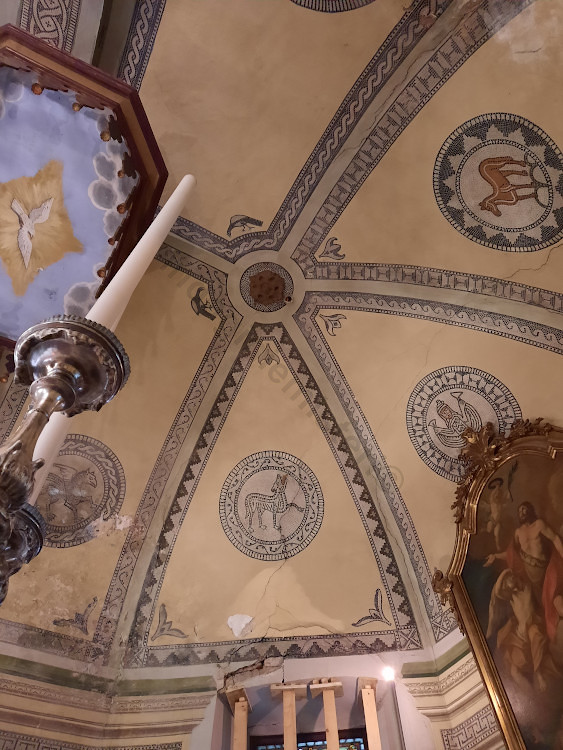
Symbolic meaning of the mosaic figures
The symbolic meaning of the Medieval bestiary at Pieve Terzagni is probably related to the eucharistic rite. The faithful walked over his vices for purifying himself at the moment of receiving the bread. In fact, the sacrifice of Christ allows to set free from the slavery of sin. Further, the mosaic tiles make twelve animals. This number is not random, since it symbolizes the totality according to the Christian numerology. The eucharistic rite has got a universal value because through it humanity is redeemed.
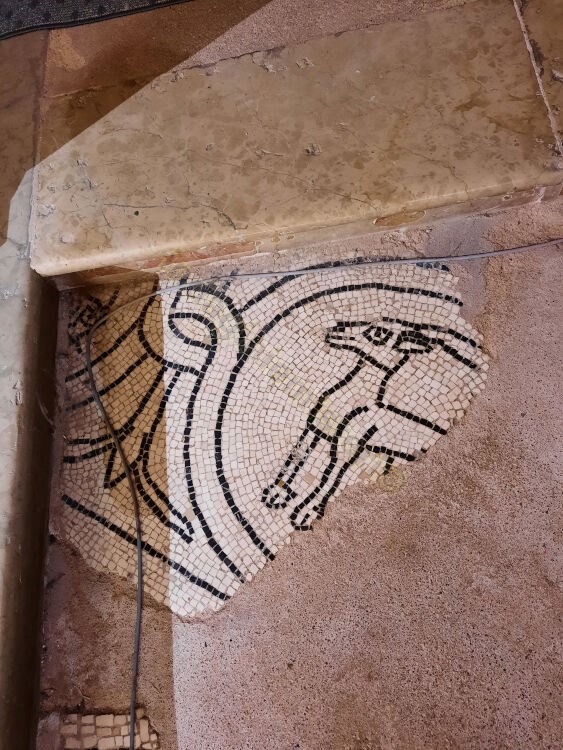
The Sator Square of San Giovanni Decollato
Five letters composing the Latin word Rotas stand near the lectern, inside the mosaic floor.

It is a fragment of the famous Sator Square, a palindrome inscription found in several places of Europe. Scholars have been debating about its meaning since it was discovered and the interpretations are not shared. The Sator Square is composed by five Latin words which can be read the same forwards and backwards as well as up and down.

A literal translation is the following: “the sower holds the wheels of the plough (arepo) with care”. However, the scholars have demonstrated that arepo is not an original Latin word but it was used by Gauls.
The Sator of Pieve Terzagni
According to Weerth the Sator Square was located in the central part of the presbytery. This suggests a liturgical or apotropaic function linked to the meaning of the mosaic. The position of the Sator proposed by Weerth could correspond to the the priest’s chair one. Thus, it could indicate the position where the seat was placed during the liturgy, as well as the function of the priest that takes care of its church.

Further, the Sator Square is also interpreted as symbol of the Holy Spirit. This hypothesis is suggested by the presence of the Tetramorph in a corner position. Probably, the reference to the four evangelists indicated the Merkavah: the Holy Scriptures are like a chariot of fire which reaches all the corners of the earth. This interpretation is based on the Book of Ezekiel3.
The Merkavah in the Book of Ezekiel
4 I looked, and I saw a windstorm coming out of the north—an immense cloud with flashing lightning and surrounded by brilliant light. The center of the fire looked like glowing metal, 5 and in the fire was what looked like four living creatures. In appearance their form was human, 6 but each of them had four faces and four wings. […].
10 Their faces looked like this: Each of the four had the face of a human being, and on the right side each had the face of a lion, and on the left the face of an ox; each also had the face of an eagle. 11 Such were their faces. They each had two wings spreading out upward, each wing touching that of the creature on either side; and each had two other wings covering its body. 12 Each one went straight ahead. Wherever the spirit would go, they would go, without turning as they went. […].
14 The creatures sped back and forth like flashes of lightning. 15 As I looked at the living creatures, I saw a wheel on the ground beside each creature with its four faces.
16 This was the appearance and structure of the wheels: They sparkled like topaz, and all four looked alike. Each appeared to be made like a wheel intersecting a wheel. 17 As they moved, they would go in any one of the four directions the creatures faced; the wheels did not change direction as the creatures went. […].
20 Wherever the spirit would go, they would go, and the wheels would rise along with them, because the spirit of the living creatures was in the wheels.
Merkavah and the Sator Square of Pieve Terzagni
The biblical Merkavah is a metaphor of the Word of God which is guided by the Holy Spirit. According to the exegesis of the Bible book, the chariot is accompanied by the Tetramorph figures that symbolize the four evangelists. Exactly as the Sator inscription, the Merkavah proceeds to all directions with its wheels, reaching each corner of the World. So in that sense, the Holy Spirit is the Sator: the one who takes care of the wheels. Probably, the Latin inscription was used as a liturgical invocation to the Third Person of the Trinity. Ideally and figuratively, the palindrome symbolized the spread of the Holy Scriptures.
Samuele Corrente Naso
A special acknowledgment to the religious authorities who allowed us to visit the church of San Giovanni Decollato and for their kind availability.


